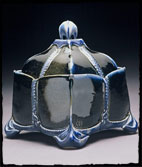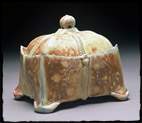



Lady Vases


Square Box


Cups
Forrest Snyder
"I'm at the beginning of the beginning," Kristen Kieffer explains as we sit down to talk on a late fall day in Worcester, Massachusetts. "While I have shown for a few years, I'm not remotely in the middle of starting." It's quiet in the middle of the day, most of Ms. Kieffer's studio mates lead full lives which often find them elsewhere. She has plenty of time to reflect and work through the issues of becoming a full-time studio potter.
As we look over the wareboards filled with drying work, Kristen explains that she's a good way into making work for a sale held in Demarest, New Jersey. A handwritten list of forms and the number she'll make hangs off of a nearby shelf post. Ten teapots are crossed off the list; there they sit, nearly bone dry. Next to the cut, darted, carved, and slip-trailed decorated teapots sit a number of flower "boats" drying as well. Other shelves hold dozens of brightly glazed cups and saucers, "lady vases," cream and sugar sets, and covered jars. However, the list is long and there are quite a number of forms yet to be made.
"I work in a series, but I work very slowly. My ideas, my forms change slowly," Kristen says. "For instance, I made two series of teapots last year. That's sixteen teapots. Only sixteen chances to experiment and progress!" Nonetheless, she develops two new forms each year. "Evolution within forms take longer. Sometimes things just seem to happen. Solutions have been cooking in my head and then come to fruition at the right opportunity," she explains. "I try not to get fixated on making a living while I'm actually making. That's for when I'm lying awake at night."
This last point has been one of much consideration (and not a little anguish). She recently completed a beginning business course. The primary objective of the class was to write a detailed business plan for the proposed venture. In typical fashion, Kieffer researched and dissected all of the aspects of working as a potter. Material costs, living expenses, studio rental, firing fees, shipping, and more all went into the mix. In the end, she had a detailed business plan that essentially proved she could never make a living as a full-time studio potter.
Kristen is out to disprove her own research. She has formulated a plan she hopes will allow her to flourish. Namely, she teaches pottery courses at the local crafts guild, gives workshops around the country, participates in several retail sales each year, and is represented in about a half dozen galleries across the country. Both help supplement her studio income. In addition, these opportunities feed her in ways that she cannot alone in her studio; "I came back totally jazzed," from a recent workshop at Arrowmont, she enthused. "As a teacher and artist sharing my ideas and having to articulate them to others is defining and self-informative," she says. Finally, Kristen has launched a website to find a greater audience for her work and also gain exposure for potential workshops.
We talk at length about the tensions between artistic growth and making work that is commercially viable. As she explains, "if I only wanted to make pots, the same pots,I could do that off somewhere in relative peace and solitude and get paid for doing it. I worked for a year making production pottery at Greenfield Village (a living history museum outside of Detroit, Michigan). I made 200 pots each month to fulfill my obligation, and I was good at it, but just making pots wasn't enough for me. I wanted to make my own pots. Pots which would be uniquely my own, and, finally, pots which contribute to the field of ceramics."
Ms. Kieffer is always in investigative mode. She investigates interests from ancient pottery to contemporary design to find those objects and aesthetics that resonate. Two areas that have been strong reoccurring influences are colonial and Victorian metal vessels and women's high fashion from similar eras. Over the years, she's collected a number of pewter and silver tea and coffee service pieces. In these works, Kristen finds the refined, one might say confined, ornament with curving cuts and scroll work of ongoing fascination. The second source of inspiration repeatedly comes from 18th and 19th century women's fashions and the weight and pattern of the fabrics. Much of the intrigue comes from what's under the ultra feminine finery, the rarely seen undergarments and their role in the final presentation. Indeed, surrounding the potter's wheel in the corner studio are image after image of female silhouettes, corsets, garters, and other examples of feminine fashion. Kristen Kieffer points out that these two art forms were not isolated. Much of the silver teapots, when seen in profile, posses a distinctively womanly shape.
Through these objects of interest - ornate silver work and Victorian high fashion - combined with simple observation - the claw foot on an old bathtub - Kieffer has developed a unique vocabulary of shapes and forms. These sources are recorded in sketchbooks as extensive drawings and notes. As the pages fill up, the studies merge and becoming new objects - the claw foot becomes a foot on a vase, the 19th century corset finds its way into the cut sides of a pot, the swirling pattern of a heavy velvet fabric leads to layered slip trailing.
With time and energy precious, Kieffer is hesitant to try a new form or idea until she's considered it at length. She explains, "I'm tentative until I really know an idea. I obsesses about a particular form over days, weeks, and months." Kristen points to a where a pulled handle joins a flower boat, "that bugged me for over a year. I turned it over and over in my head and finally came up with something better." At the same time, Kieffer often wonders, "why make anything that is not absolutely mine?" She sees these personality traits as both hindrance and boon. While new ideas may be slow in coming, when they finally do realize themselves in the physical world, it is with uniqueness and confidence.
Part of her thinking process, too, is of a technical nature. Kristen states plainly, "I know the wheel; that's how I think." Her thrown parts become significantly altered through cutting out shapes and rejoining the walls, a process called darting. With great precision on these reshaped pieces, Kristen carves and cuts decoration, creates patterns with custom stamps, adds sprigs (small decorative additions), and trails light lines of slip. Kieffer carefully considers other technical areas, working with a familiar white stoneware, reduction soda fired to a solid cone 10 using a small palette of glazes.
Rather than surface, Kristen places her primary efforts on form. It's not that surface isn't important, she acknowledges, but she puts so much time and effort into her forms that she doesn't want a pots surface to be distracting or somehow incongruous. "I want to work in the clay, not on the clay," she states emphatically.
After the precision and expert control with which she builds the work, Kristen allows the glazing, and more specifically the glaze firing, to be an opportunity for the unexpected. She uses one or two glazes on each piece that will pool and break in the soda firing.
Getting back to the idea of "knowing the wheel" as a primary tool, Kieffer has made a very conscious effort in the last year to go beyond the round and cylindrical. To this end, she's been working on a series of flower boats - large vases made for a wide sweep of flowers. While still very symmetrical, a bias she admits to loving and not being able to escape, these pieces have been cut, darted, and altered in such a way as to leave most of the round heritage of a wheel thrown pot behind. "I got very bored with round and see darting as giving me the ability to play with silhouettes and give crisp lines... it's like drawing."
As the subtitle of the flower boats, "Corset Series," implies, Ms. Kieffer is interested in the intimate, that is, the psychological intimate, and how it might find it's way into form. Similarly, she's addressing beauty through unconventional means. "I enjoy the humor related to alluding to lingerie with pots. Initially, I liked that the pots were somewhat sexy, but now, more pointedly, they are about intimacy, the potential for beauty to contain beauty, and the revelry of quiet sensuality."
Kristen Kieffer calls her time spent in the studio, "my pots working on my pots." They form a chain of thought, playing off one another, each one whispering secrets to the next. If her current work is any indication, she's succeeded in her pursuit to be a growing, passionate artist.
Links
Kristen Kieffer
http://www.kiefferceramics.com
Forrest Snyder
940 Water Street, #5
2nd Floor
North Bennington, Vermont 05257
Email: forrest@forrestsnyder.com
http://www.forrestsnyder.com

Flower Boat


Creamer & Sugar


Yellow Box